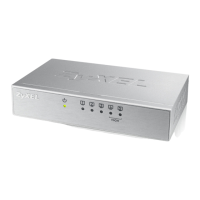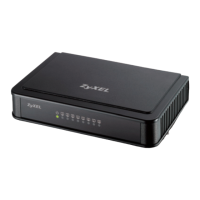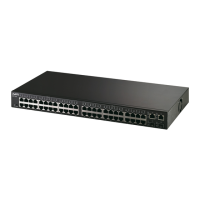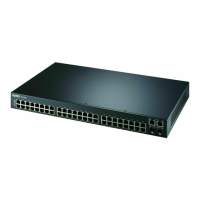Do you have a question about the ZyXEL Communications ES-3124 and is the answer not in the manual?
Critical safety instructions for device operation, covering environmental conditions and electrical precautions.
Contact information and support channels for assistance with the product.
Introduction to the manual, switch models, and conventions used throughout the guide.
Description of general software capabilities including DHCP Client and protocol support.
Details on physical components like Ethernet ports, SFP slots, and PoE capabilities.
Instructions for placing and installing the switch in a freestanding configuration.
Guide for installing the switch into a standard 19-inch equipment rack.
Identification and description of front and rear panel connectors and ports.
Explanation of the status indicators (LEDs) on the switch for monitoring.
Steps to access the web interface using a browser and default credentials.
Procedures for restoring the switch to its factory default configuration.
Procedure for configuring Virtual Local Area Networks for network segmentation.
Steps to set the IP address for managing the switch over the network.
Viewing general system information, hardware status, and firmware version.
Configuring global switch parameters like VLAN type and MAC address learning.
Configuring IP addresses, subnet masks, and default gateways for management.
Explanation of tagged VLANs, frame formats, and VLAN ID concepts.
Configuration steps for manually assigning ports to VLANs.
Configuring VLANs based on port membership for traffic segmentation.
Explanation of Spanning Tree Protocol (STP) and Rapid STP (RSTP) functionality.
Detailed steps for configuring Rapid Spanning Tree Protocol (RSTP) settings.
Introduction to IEEE 802.1x and RADIUS for network port security.
Steps to enable and configure IEEE 802.1x port authentication.
Configuration steps for enabling port security and MAC address limits.
Procedure to reset the switch to its original factory default settings.
Steps for updating the switch's firmware to a newer version.
Explanation of the Simple Network Management Protocol (SNMP) and its components.
Configuration of trusted computers for secure remote management access.
Methods to connect to the Command Line Interface via console or Telnet.
Explanation of User, Enable, and Configuration command modes.
Enabling and configuring Spanning Tree Protocol (STP) on the switch.
Configuration of port authentication using RADIUS server settings.
Explanation of subnet masks and their role in network segmentation.
Process of dividing networks into smaller logical networks using subnet masks.
| Brand | ZyXEL Communications |
|---|---|
| Model | ES-3124 |
| Category | Switch |
| Language | English |











